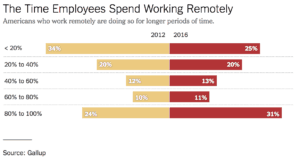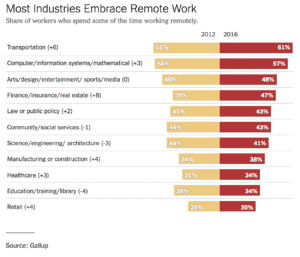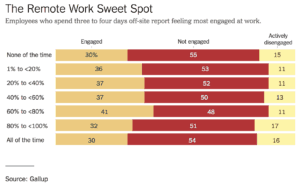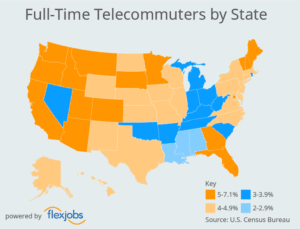4.3 million U.S. employees (3.2% of the workforce) now work from home at least half the time according to GlobalWorkplaceAnalytics.com (July 2018)
More American employees are working remotely, and they are doing so for longer periods, according to a Gallup survey. 43 percent of employed Americans said they spent at least some time working remotely, according to the survey of more than 15,000 adults.
That represents a four percentage point increase since 2012, a shift that meets the demands of many job seekers.
“Gallup consistently has found that flexible scheduling and work-from-home opportunities play a major role in an employee’s decision to take or leave a job,” the polling agency wrote in a report on those and other workplace findings.
“Employees are pushing companies to break down the long-established structures and policies that traditionally have influenced their workdays.”
Employees and some employers view the practice as broadly beneficial, saying that remote workers are more productive and that the additional flexibility can help to close the gender gap.
Those who work remotely do so for longer periods
It is not just that more working Americans are working off-site; they’re doing so more often, too.
The share who said they spent a day or less a week working remotely shrank substantially from 2012 to 2016, falling to 25 percent from 34 percent.
At the same time, the share that reported working remotely four to five days a week grew by nearly the same amount, rising to 31 percent from 24 percent.

Not all industries embrace remote work
Although widespread, the shift toward remote work is not universal.
Remote work was less common last year than in 2012 for Americans employed in the fields of community and social services; science, engineering and architecture; and education, training and library.

Most industries, however, have embraced the idea — none more rapidly than the finance, insurance and real estate industries. The share of workers in those fields who report working remotely at least sometimes rose eight percentage points, to 47 percent, from 2012 to 2016.
In the transportation, computer, information systems and mathematics industries, well over half of the employees work remotely some of the time.
But even in industries where the practice is popular, companies have struggled with how much to embrace remote work. In 2013, Yahoo received a lot of attention when it sought to bring workers back to the office. Last October, Aetna, the insurance giant known for its embrace of remote work, did the same.
The remote working sweet spot
In 2012, the workers who said they felt most engaged while working remotely were those who spent the least amount of time off-site. By 2016, that was no longer true.

Workers who spend none or all of their time out of the office reported feeling equally engaged last year. Those who spent 60 percent to 80 percent of their time away from the office had the highest rates of engagement.
“In spite of the additional time away from managers and co-workers, they are the most likely of all employees to strongly agree that someone at work cares about them as a person, encourages their development and has talked to them about their progress,” Gallup reported.
Those who spend three or four days a week working remotely were also the most likely to report thinking that they had a best friend at work and had opportunities for professional growth.
Which States have the most people working from home?
FlexJobs just did a state-by-state analysis of telecommuting based on Census data and found that Colorado, Vermont, and Oregon continue to top the list, as they have for the past five years.

The Top 10 States for Telecommuting
The top three states for telecommuting haven’t changed since previous data in 2013: Colorado, Vermont, and Oregon still lead the nation in telecommuting activity, though their telecommuting activity remains largely unchanged year over year. Of note in the top 10 states, whose rankings changed little, New Hampshire moved up from number 8 to number 5 because of an almost 13% increase in telecommuting.
States with Large Increases in Telecommuting
Outside of the top 10 states, Wyoming had the largest increase in telecommuting in the last three years, with almost 30% more telecommuters in 2016 than 2013, which moved the state from 38 on the list to 19. Rhode Island experienced a 19.4% increase in telecommuting, and other locations with fast-growing telecommuting populations include the District of Columbia (18.2%), Delaware (16.2%), Alabama (16%), Mississippi (15.8%), Arkansas (14.3%).
They’re not alone. FlexJobs found that 3.9 million U.S. employees (Jan 2018) (2.9% of the total U.S. workforce) work from home at least half of the time, up from 1.8 million in 2005.
States that have seen a rise in the number of people working from home are Wyoming (nearly 30% more since 2013), Rhode Island (19.4%), and Washington, D.C. (18.2%).
Below are other key data points to consider when evaluating how many people work from home in the USA.
- Regular work-at-home, among the non-self-employed population, has grown by 140% since 2005, nearly 10x faster than the rest of the workforce or the self-employed.
- From 2015 to 1016:
- The employee population as a whole (not including work-at-home) grew by .9% from 2015 to 2016.
- The self-employed population grew by 2.4% (not including home-based) and the home-based self-employed population grew by 7.3%.*
- Almost all of the growth in self-employment since 2005 is among the home-based incorporated businesses (up 43% from 2005 to 2016)
- The telecommuter population grew by 11.7%, the largest year over year growth since 2008.
- Forty percent more U.S. employers offered flexible workplace options than they did five years ago. Still, only 7% make it available to most of their employees.
- Larger companies are most likely to offer telecommuting options to most of their employees.
- New England and Mid-Atlantic region employers are the most likely to offer telecommuting options.
- Full-time employees are four times more likely to have work-at-home options than part-time workers.
- Non-union workers are twice as likely to have access to telecommuting, but union employee access is growing rapidly.
While there is no Census Bureau or government produced data provides additional granularity on the frequency of telework, Global Workplace Analytics’ research finds that:
- 50% of the US workforce holds a job that is compatible with at least partial telework and approximately 20-25% of the workforce teleworks at some frequency
- 80% to 90% of the US workforce says they would like to telework at least part-time. Two to three days a week seems to be the sweet spot that allows for a balance of concentrative work (at home) and collaborative work (at the office).
- Fortune 1000 companies around the globe are entirely revamping their space around the fact that employees are already mobile. Studies repeatedly show they are not at their desk 50-60% of the time.
- A typical telecommuter is college-educated, 45 years old or older, and earns an annual salary of $58,000 while working for a company with more than 100 employees. 75% of employees who work from home earn over $65,000 per year, putting them in the upper 80th percentile of all employees, home or office-based.
* Note: It is critical to separate the self-employed from the employee telework and telecommuter population for the purpose of understanding trends as they are moving in opposite directions. About 15% of the self-employed population work primarily from home (2016 data). That population (self-employed not including home-based) grew by only 7.9% since between 2005 and 2016. Over the same period, the self-employed home-based business population declined by 26.5% but the incorporated portion of the home-based population grew by 43.2%.
Who is the average work from home person?
A typical telecommuter is older (50+), college educated, salaried, non-union employee.
Relative to the total population, a disproportionate share of employees in the following occupations telecommute (in order of largest disproportion to smallest):
- Military
- Computer and Mathematical
- Arts, Design, Entertainment, Sports, and Media Occupations
- Farming, Fishing, and Forestry
- Life, Physical, and Social Science Occupations
- Legal Occupations
- Community and Social Service Occupations
- Architecture and Engineering Occupations
- Business and Financial
Using home as a ‘reasonable accommodation’ per the Americans with Disabilities Act, 463,000 disabled employees regularly work from home (7.1% of the disabled).
Non-exempt employees are far less likely to work at home on a regular or ad hoc basis than salaried employees.
Larger companies are more likely to allow telecommuting than smaller ones.
Non-union organizations are more likely to offer telecommuting those with unions.
